- Home
- Tom Clancy
Battle Ready sic-4 Page 6
Battle Ready sic-4 Read online
Page 6
At one trench, hedgerow,[12] and trail complex in an area loaded with booby traps, it was decided to go one at a time. When Zinni’s turn came, he ran and jumped the trench, but as he landed, he felt his boot drag across a wire. He immediately went limp, hit the ground, and flattened out as a muffled explosion detonated behind him. He wasn’t hit, he realized, to his immense relief. But when he looked back into the dust-filled trench, he noticed movement at the bottom. A Marine was lying there, one of the company cooks, in obvious pain, his face mangled. Since they were crossing one at a time, he should not have been there; but he had rushed across right on Zinni’s heels, contrary to instructions.
Though he had taken a blast in his upper body, remarkably he was still alive. He’d been carrying a small cage with two doves in it, no doubt dinner. The doves were unharmed.
Zinni and other nearby Marines jumped into the trench to help him. Zinni then called in a medevac, but did not hold out much hope, since the man was bleeding badly from both eyes.
Several months later, Zinni learned that he had survived, though with the loss of his eyes.
At another path crossing one day, Zinni stepped into a shallow, camouflaged pit. He tensed, expecting sharp bamboo stakes to pierce his foot; but nothing happened. Puzzled but relieved, he climbed out, and the camouflage was cleared away, revealing the real nature of this booby trap — though fortunately, its shelf life had expired. At the bottom of the pit was a small dead snake, a krait, one of the most poisonous of all the vipers. (There had been no food in the pit, and it could not climb the pit’s sheer walls.)
The VC also placed booby traps in likely helicopter landing zones, making heliborne assaults sporty and medevacs dangerous. Since the American adviser ran the medevacs, Zinni had to check out the zones to ensure they were safe for the helicopters. He always performed this task with great care, concentration, and gingerly placed steps.
In placing booby traps, the VC did not distinguish combatants from noncombatants. Any kind of cooperation was punished. Civilians who assisted Vietnamese forces less often came home to bombs set to go off at their arrival. Even civilians required to gather in designated areas for processing of identification paperwork or for government information programs might find explosive devices in their homes or villages. Since the processing was compulsory, the ordinary people were once again caught between a rock and a hard place.
Their susceptibility to booby traps aside, the Vietnamese Marines were masters of fieldcraft.
The Vietnamese Marines traveled light. They lived off the land, partly out of necessity and partly out of the importance they placed on being light and mobile like the enemy. This points out the most significant difference between the Vietnamese Marines and their American allies.
Americans always took it for granted that the full might of America was behind them. Not only did they expect to get three squares a day, but American units always operated under the conviction that, no matter what, they would somehow get bailed out and that American firepower would prevail. Sure, there might be an occasion where you got stranded for a while before help came, but eventually help was going to get to you — rescue, firepower, or logistics.
The Vietnamese Marines did not have that certainty. They never knew if they were going to eat on any particular day. When they got in a firefight, there was no guarantee that the cavalry was going to come and save them. They knew they had to fight with what they had.
Thus they had no use for the heavy loads American soldiers carried, and their carelessness with weapons and supplies; and they were happy to do without the daily helo resupply lifts that gave away positions.
The Vietnamese Marines were masters of make-dos and work-arounds. They ingeniously prepared fighting positions, living facilities, early warning alarms, and many other needs from what was available in the bush. A premium was placed on quick reaction and agility on enemy contact. They were well aware of these qualities in the enemy they faced.
Their gear was not only light but practical. They slept in nylon hammocks tied with nylon cord, compact enough to fit into the cargo pocket of their tiger-striped field uniform. The U.S. jungle hammock, by contrast, was heavy and bulky and totally unsuitable for the field. Cooking stoves were small and made of lightweight aluminum, as were their food containers. Their packs were the original rucksacks that made stowing and carrying gear easy for infantry units on the move. They rarely wore flak jackets and preferred camouflaged soft hats rather than helmets, especially on patrols. Light, loose-fitting nylon rain gear was often purchased by the Marines to replace the heavy rubberized U.S. ponchos they were issued. They did, however, cherish the soft American poncho liner, which, along with the jungle boot, was probably the best piece of gear to come out of the Vietnam War.
Their weapons were a hodgepodge of World War Two American small arms, mortars, machine guns, recoilless rifles, and artillery pieces. These included M-1 rifles, carbines, submachine guns, and other vintage weapons.
During Zinni’s tour in 1967, the VNMC received the M-16 rifle and M-60 machine gun, but the process was closely controlled by the U.S. The policy was that no Vietnamese units could get them until every American unit had them, and then the Marines and airborne units would be the first to receive them. In reality, the Vietnamese already had a few M-60 machine guns before they were officially supposed to get them. They’d either been captured from the enemy or scrounged from U.S. units by the advisers.
Reports of the M-16’s unreliability preceded its arrival. The plan was to pull the VNMC battalions back, one at a time, to the national training center for two weeks to switch weapons and go through a training program on the new rifle.
U.S. Marines brought the weapons to the center and oversaw the delivery and training. But just as the first units to receive the new rifles began their training, an emergency developed in the Mekong Delta area. The units were pulled out and sent to engage a large enemy force there, even before they had actually fired their new weapons (they’d barely gotten the first classes on care and cleaning). They performed brilliantly, defeating a tough force in fierce fighting. The fact that no weapons jammed or malfunctioned drew considerable attention from the U.S. military command; and an investigation was launched. But the explanation was simple: The Vietnamese Marines cleaned their weapons. They were meticulous — almost obsessed — with weapons care, often complaining to Zinni about American carelessness with weapons and equipment.
They were just as meticulous about fire discipline. They were, for example, masters at hiding their crew-served weapons and not opening up in response to probes by North Vietnamese or mainline VC units (the idea was to get them to fire so they could pick out the key weapons they needed to take out).
The emphasis on care and conservation carried over to most other areas.
Like all Vietnamese, the Vietnamese Marines enjoyed the midday break. Unless operational necessity demanded otherwise, they would stop to string up their hammocks for a couple of hours during the hottest part of the day for a noon siesta. But they also took care to rest at any other time that offered itself. Whenever possible, they conserved resources, strength, and the energy of the unit.
Their endurance was remarkable. They could walk all day, day after day. But they were not especially strong. Rather, they tried to pace themselves and conserve energy.
American commanders were all in a hurry. They wanted to end the war on their one-year tour of duty. Vietnamese commanders realized they would be in it for the duration. Though they never backed down or failed to fight bravely, they did weigh risks carefully and approach battle methodically. Plunging headlong into battle, as Americans liked to do, was not an option for the Vietnamese.
Zinni had this truth pressed home on an operation in II CTZ. Here is how he remembers it:
It was summer, and our VNMC battalion had been operating for weeks in an area astride Highway 1 when we pulled back for a much-needed day of rest in a village along the highway. The battalion commander, the senior advis
er, and most of the officers and troops went to a nearby city for an R & R break, while I stayed behind with the units that were the designated security element. The battalion operations officer, a lieutenant, was the officer in charge. He was a bright young officer and we had become instant friends.
On one hot summer day, with the stay-behind troops resting, cleaning equipment, or manning the small security guard, an excited, very animated woman came running up to our location.
“The VC are holding a meeting with local communist bigwigs in a nearby hamlet west of the highway,” she cried.
“We have to go get them,” I told the ops officer.
He was not so sure. All the commanders were gone and this was a big decision for him, especially since he only had bits and pieces of units available for the mission.
But he was an aggressive officer, and I knew I could get him to go. And that’s what happened. We quickly grabbed a group of Marines, saddled them up, and charged off.
As luck would have it, we caught the VC as they were leaving the hamlet after their meeting broke up. A running, chaotic gun battle followed, as we chased them into the countryside. The chase went on for several hours, and we moved farther and farther into the brushy foothills west of the highway.
During the pursuit, we managed to capture one VC and could tell from the blood trails that we had hit others. But in our excitement and enthusiasm we failed to realize how far we were moving from our base of operations. Enemy fire was also picking up, and the terrain was becoming more rugged. Though I didn’t realize it then, it was becoming distinctly possible that we would be drawn into a trap.
Eventually, we received a radio call from the obviously angry battalion commander, ordering us to break off contact and return to the base area.
On the way back, I realized I had put my Vietnamese lieutenant buddy in a bad position. He was not looking forward to seeing the battalion CO.
And sure enough, the commander had harsh words for him, and likewise my senior adviser had harsh words for me. Though I was upset that we’d had to break contact, I kept quiet about that. Instead, I tried to take the fall for the action, and explained that I had convinced my friend to go.
Later, the battalion commander asked to speak to me privately. He was a highly decorated officer, tactically brilliant and courageous; and I had great respect for him.
“Look,” he explained to me, “my unit is not a U.S. Marine unit. It’s smaller and less capable, we don’t have a steady stream of replacements flowing into it, and I can’t rely on the formidable arsenal of firepower that U.S. units have at their disposal. [13]
“My troops,” he continued, “have fought for years; they’ll fight for many more; and the enemy will still be there tomorrow. All of this means I have to carefully choose where and when I take risks that might bring me a disadvantage on the battlefield. [14]
“This is not,” he explained, “a matter of courage, aggressiveness, or fighting spirit; and I hope you’ve seen enough of those qualities in my Marines to know that wasn’t the issue.”
In this, I totally agreed with him. And I also fully understood all of his very valid points. Yet privately the U.S. Marine in me still found it difficult to pass up an opportunity to mix it up with the enemy, regardless of the circumstances.
“Do you have any idea why the VC didn’t break contact and fade into the countryside?” he then asked me. “After all, they’re masters of that sort of tactic.”
It was a good question. As I thought back on the firefight and chase, I realized how easy it would have been for them to break off the fight. Instead, they stayed engaged. They’d take a few shots, and then withdraw, leaving easy signs to follow.
That was when it dawned on me that we’d been in danger of getting lured out into the hinterland, far from our base and support, where they had forces positioned to ambush us.
“You’re right,” I admitted. “We were brash to chase them. But please be aware that doing it was my fault. Don’t take it out on your operations officer.”
“Don’t worry,” he said with a smile. “I’m satisfied that two young lieutenants learned something… without serious consequences, for a change.”
In time, Zinni became an expert in firefights and had a wealth of other experience about how to move in a fight, how to conduct a patrol, how to cross a road, how to deal with snipers in trees, how to build alert systems with bamboo and vine (the bamboo would clap). He became a collector of these techniques.
He quickly discovered that many of the techniques he had been taught were wrong — lessons learned from old wars. He had a passion to get such things right. The best fighting techniques bring an obvious advantage; they can keep you alive. But Zinni was also a committed professional. The best military leaders will play their units as the best conductors play an orchestra, blending and focusing disparate elements into a single, splendid “sound.” However this was done, Zinni wanted to practice and perfect it.
He has further thoughts on this:
Right from the beginning of my Marine Corps career, what most fascinated me as we would engage in tactical problems during field exercises is that it was all about facing an enemy, trying as hard as he could to do to us what we wanted to do to him… You didn’t just go into a patch of woods and that’s it, like a hiker. There’s an enemy somewhere in there, and here you are trying to use everything you know, have learned, and have trained for, in order to reach your aims… and stop him from reaching his.
You don’t get much more real than that.
I’ve always had a theoretical understanding of sports — offense and defense, how you organize plays, and what you’re trying to do. But, of course, the theory is one thing, and playing is another.
And in a firefight, you’re experiencing much higher levels of complication and risk — all the bullets flying, the rounds, the explosions, the confusion — and you’re trying to figure it out, trying to move quickly on a course of action that makes sense, and keeps you and your buddies alive.
What’s really going on? How do you organize yourself? How do you apply the fires? How do you move against your enemy? What are the techniques you need to use?
For example, if you’re out in the woods, and you’re trying to find your enemy, you don’t want him to find you. What techniques will best bring that outcome? What do you need to know?
I was always really interested in learning everything I could about that. I’ve always been a collector of small-unit fighting techniques. It’s always fascinated me… consumed me. I’m a Catholic. In my faith, we think of the priesthood as a calling — a “vocation,” requiring total dedication. I looked at the “call to arms” the same way. The warrior profession is a calling, and requires the same kind of dedication the priesthood does. That meant that I read books about it — history books about small unit warfare, books about Burma, Malaya, and Vietnam before our war (places where the fighting was similar to what we were experiencing).
Some of what I picked up from books, or from my instructors, turned out to be bogus. Even before I went to Vietnam, it didn’t make sense to me; it didn’t seem natural; it didn’t jive with what was really likely to happen. I don’t know where the people came up with it.
And then when I got out there in, say, the II CTZ, we were doing it for real; and a lot of what I’d been taught made even less sense.
But there I couldn’t have had better teachers. I would watch the Vietnamese, who of course had incredible battlefield experience, and I was able to see how they did things and really analyze their technique.
One great thing about being an adviser: You’re not commanding the troops. Sure, you’re busy; you have to be ready to apply fires and all the other responsibilities advisers had. But you also have a lot of opportunity just to observe, from a semidetached point of view. You could watch how the fighters moved, you could listen to what they were saying. And since you weren’t directly caught up in the action, you could think through it and analyze it.
Lat
er, I’d ask the seasoned veterans about it: “Why did you do this?” and “What do you think about this?” And they would talk to me about their experiences.
It was from this seed in low-level tactics that my career started to grow, eventually leading to the construction of multinational strategies at CENTCOM and elsewhere where I’d be dealing with a part of the world where we were trying to develop a military relationship and a military policy.
One especially vital type of tactical knowledge is what we might call the “sense of a firefight.” That is, the sense from sound and visual cues of what is actually happening when the bullets are flying. Closely allied to that is a sense of what you have to do to respond and act. These can only be learned from experience. Tony Zinni also has further thoughts on this:
Though I had a lot of operational experiences from the beginning of my time with the Vietnamese Marines, it took about three months into my tour before I was at a level of competency where I had a real “sense of a firefight.”
At first, when there was shooting, it was a cacophony of sounds to me. I didn’t know what was going on. I had no idea whether I was in World War Three or a small firefight. At the beginning, I wasn’t even sure which direction the firing was coming from.
But by the end of three months, I could tell which kinds of weapons were firing, where they were firing from, and about how far away they were. I could also get a pretty good sense of what was happening by the way the firing was taking place: Was somebody just taking potshots? Or was the firing building up to a larger engagement? Was the enemy going to stand and hold in place (and all the implications of that)? Or were they simply going to engage us and then try to move away?
By three months, I could quickly process situations like these with just a few sensings.
Something similar goes on with really good athletes when the play is really intense.

 Changing of the Guard
Changing of the Guard Clear and Present Danger
Clear and Present Danger Hounds of Rome
Hounds of Rome Breaking Point
Breaking Point Tom Clancy's Jack Ryan Books 7-12
Tom Clancy's Jack Ryan Books 7-12 Full Force and Effect
Full Force and Effect The Archimedes Effect
The Archimedes Effect Combat Ops
Combat Ops Into the Storm: On the Ground in Iraq
Into the Storm: On the Ground in Iraq Under Fire
Under Fire Point of Impact
Point of Impact Red Rabbit
Red Rabbit Rainbow Six
Rainbow Six The Hunt for Red October
The Hunt for Red October The Teeth of the Tiger
The Teeth of the Tiger Conviction (2009)
Conviction (2009) Battle Ready
Battle Ready Patriot Games
Patriot Games The Sum of All Fears
The Sum of All Fears Fallout (2007)
Fallout (2007) Red Storm Rising
Red Storm Rising The Cardinal of the Kremlin
The Cardinal of the Kremlin Executive Orders
Executive Orders Lincoln, the unknown
Lincoln, the unknown Threat Vector
Threat Vector The Hunted
The Hunted Shadow Warriors: Inside the Special Forces
Shadow Warriors: Inside the Special Forces End Game
End Game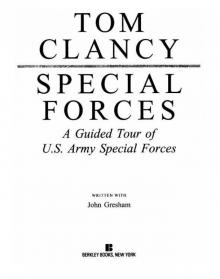 Special Forces: A Guided Tour of U.S. Army Special Forces
Special Forces: A Guided Tour of U.S. Army Special Forces Locked On
Locked On Line of Sight
Line of Sight Tom Clancy Enemy Contact - Mike Maden
Tom Clancy Enemy Contact - Mike Maden Fighter Wing: A Guided Tour of an Air Force Combat Wing
Fighter Wing: A Guided Tour of an Air Force Combat Wing Springboard
Springboard Line of Sight - Mike Maden
Line of Sight - Mike Maden EndWar
EndWar Dead or Alive
Dead or Alive Tom Clancy Support and Defend
Tom Clancy Support and Defend Checkmate
Checkmate Command Authority
Command Authority Carrier: A Guided Tour of an Aircraft Carrier
Carrier: A Guided Tour of an Aircraft Carrier Blacklist Aftermath
Blacklist Aftermath Marine: A Guided Tour of a Marine Expeditionary Unit
Marine: A Guided Tour of a Marine Expeditionary Unit Commander-In-Chief
Commander-In-Chief Armored Cav: A Guided Tour of an Armored Cavalry Regiment
Armored Cav: A Guided Tour of an Armored Cavalry Regiment Tom Clancy's Jack Ryan Books 1-6
Tom Clancy's Jack Ryan Books 1-6 The Ultimate Escape
The Ultimate Escape Airborne: A Guided Tour of an Airborne Task Force
Airborne: A Guided Tour of an Airborne Task Force Debt of Honor
Debt of Honor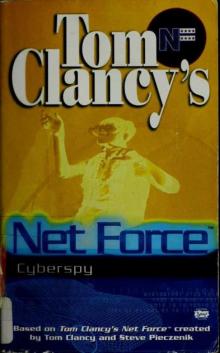 Cyberspy
Cyberspy Point of Contact
Point of Contact Operation Barracuda (2005)
Operation Barracuda (2005) Choke Point
Choke Point Power and Empire
Power and Empire Every Man a Tiger: The Gulf War Air Campaign
Every Man a Tiger: The Gulf War Air Campaign Endgame (1998)
Endgame (1998) EndWar: The Missing
EndWar: The Missing Splinter Cell (2004)
Splinter Cell (2004) The Great Race
The Great Race True Faith and Allegiance
True Faith and Allegiance Deathworld
Deathworld Ghost Recon (2008)
Ghost Recon (2008) Duel Identity
Duel Identity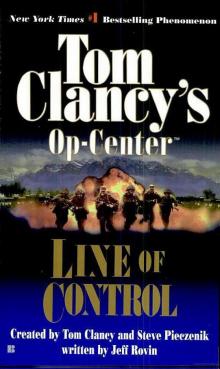 Line of Control o-8
Line of Control o-8 The Hunt for Red October jr-3
The Hunt for Red October jr-3 Hidden Agendas nf-2
Hidden Agendas nf-2 Acts of War oc-4
Acts of War oc-4 Ruthless.Com pp-2
Ruthless.Com pp-2 Night Moves
Night Moves The Hounds of Rome - Mystery of a Fugitive Priest
The Hounds of Rome - Mystery of a Fugitive Priest Into the Storm: On the Ground in Iraq sic-1
Into the Storm: On the Ground in Iraq sic-1 Threat Vector jrj-4
Threat Vector jrj-4 Combat Ops gr-2
Combat Ops gr-2 Virtual Vandals nfe-1
Virtual Vandals nfe-1 Runaways nfe-16
Runaways nfe-16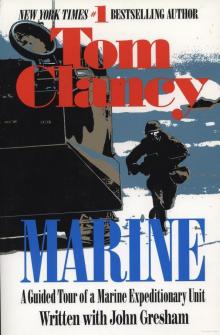 Marine: A Guided Tour of a Marine Expeditionary Unit tcml-4
Marine: A Guided Tour of a Marine Expeditionary Unit tcml-4 Shadow Warriors: Inside the Special Forces sic-3
Shadow Warriors: Inside the Special Forces sic-3 Jack Ryan Books 1-6
Jack Ryan Books 1-6 Cold Case nfe-15
Cold Case nfe-15 Changing of the Guard nf-8
Changing of the Guard nf-8 Splinter Cell sc-1
Splinter Cell sc-1 Battle Ready sic-4
Battle Ready sic-4 The Bear and the Dragon jrao-11
The Bear and the Dragon jrao-11 Fighter Wing: A Guided Tour of an Air Force Combat Wing tcml-3
Fighter Wing: A Guided Tour of an Air Force Combat Wing tcml-3 Patriot Games jr-1
Patriot Games jr-1 Jack Ryan Books 7-12
Jack Ryan Books 7-12 Mission of Honor o-9
Mission of Honor o-9 Private Lives nfe-9
Private Lives nfe-9 Operation Barracuda sc-2
Operation Barracuda sc-2 Cold War pp-5
Cold War pp-5 Point of Impact nf-5
Point of Impact nf-5 Red Rabbit jr-9
Red Rabbit jr-9 The Deadliest Game nfe-2
The Deadliest Game nfe-2 Springboard nf-9
Springboard nf-9 Safe House nfe-10
Safe House nfe-10 EndWar e-1
EndWar e-1 Duel Identity nfe-12
Duel Identity nfe-12 Deathworld nfe-13
Deathworld nfe-13 Politika pp-1
Politika pp-1 Rainbow Six jr-9
Rainbow Six jr-9 Tom Clancy's Power Plays 1 - 4
Tom Clancy's Power Plays 1 - 4 Endgame sc-6
Endgame sc-6 Executive Orders jr-7
Executive Orders jr-7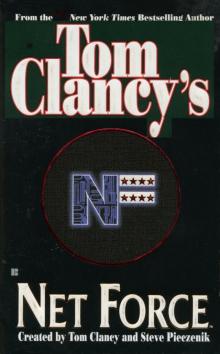 Net Force nf-1
Net Force nf-1 Call to Treason o-11
Call to Treason o-11 Locked On jrj-3
Locked On jrj-3 Against All Enemies
Against All Enemies The Sum of All Fears jr-7
The Sum of All Fears jr-7 Sea of Fire o-10
Sea of Fire o-10 Fallout sc-4
Fallout sc-4 Balance of Power o-5
Balance of Power o-5 Shadow Watch pp-3
Shadow Watch pp-3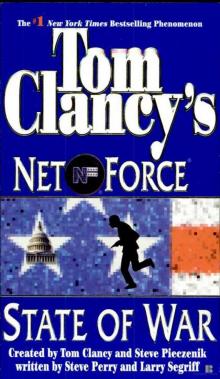 State of War nf-7
State of War nf-7 Wild Card pp-8
Wild Card pp-8 Games of State o-3
Games of State o-3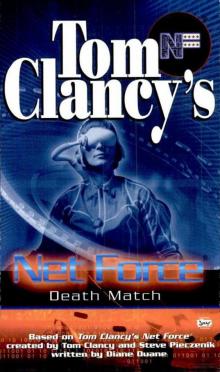 Death Match nfe-18
Death Match nfe-18 Against All Enemies mm-1
Against All Enemies mm-1 Every Man a Tiger: The Gulf War Air Campaign sic-2
Every Man a Tiger: The Gulf War Air Campaign sic-2 Cybernation nf-6
Cybernation nf-6 Support and Defend
Support and Defend Night Moves nf-3
Night Moves nf-3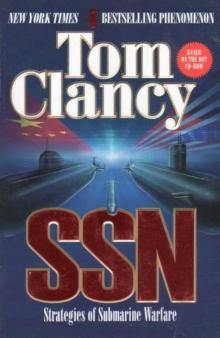 SSN
SSN Cutting Edge pp-6
Cutting Edge pp-6 The Cardinal of the Kremlin jrao-5
The Cardinal of the Kremlin jrao-5 War of Eagles o-12
War of Eagles o-12 Op-Center o-1
Op-Center o-1 Mirror Image o-2
Mirror Image o-2 The Archimedes Effect nf-10
The Archimedes Effect nf-10 Teeth of the Tiger jrj-1
Teeth of the Tiger jrj-1 Bio-Strike pp-4
Bio-Strike pp-4 State of Siege o-6
State of Siege o-6 Debt of Honor jr-6
Debt of Honor jr-6 Zero Hour pp-7
Zero Hour pp-7 Ghost Recon gr-1
Ghost Recon gr-1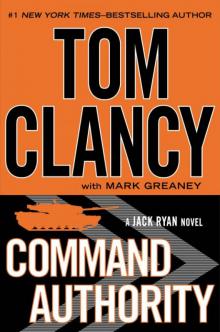 Command Authority jr-10
Command Authority jr-10 Tom Clancy's Power Plays 5 - 8
Tom Clancy's Power Plays 5 - 8 Checkmate sc-3
Checkmate sc-3 Breaking Point nf-4
Breaking Point nf-4 Gameprey nfe-11
Gameprey nfe-11 The Hunted e-2
The Hunted e-2 Hidden Agendas
Hidden Agendas Divide and Conquer o-7
Divide and Conquer o-7